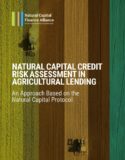A new approach to help banks evaluate the sustainability of the farming enterprises that they lend to could lead to greater recognition and reward for farmers who look after the long-term health of their soil, water, and biodiversity. The new framework, developed by Dr Francisco Ascui, Senior Lecturer in Business and Climate Change at the University of Edinburgh Business School, has been launched by the Natural Capital Finance Alliance, a coalition of over 40 international financial institutions.

Sustainable Farming Set for Funding Boost Thanks to Edinburgh Research
‘Natural capital’ is a term for the natural resources and ecosystems that provide flows of environmental goods and services that underpin the global economy. Agriculture often has both impacts and dependencies on natural capital, meaning that lenders to the sector are indirectly exposed to natural capital risk. Yet at present, banks still lend to farmers almost solely based on their most recent profit and loss accounts, not taking natural capital into account in their credit risk assessment.
This is short-sighted, because a farm’s financial performance can be improved over the short-term in an unsustainable way, for example by over-application of fertiliser, which may boost yields but causes a build-up of acidity in the soil. In the longer-term, however, this type of activity will negatively affect the farmer’s financial performance, and therefore their ability to repay a loan. The new framework, developed by Dr Ascui, takes into account factors such as water availability, use and quality; soil health; biodiversity; energy use and greenhouse gas emissions, allowing banks to identify and increase lending to more sustainably run farms.
One challenge that was, up to now, holding banks back was that natural capital risks vary considerably across agricultural sectors and geographies. What is beneficial for one crop or type of livestock may be harmful for another. The new approach sets a global generic template for natural capital credit risk assessment which can be readily adapted for different agricultural sectors and geographies, with a worked example based on wheat cropping in Australia. The approach is designed to be consistent with the leading international standard for including natural capital in business decision-making, the Natural Capital Protocol.
Dr Ascui said:
“The agriculture sector is at the front line in terms of both its impacts and dependencies on the environment. Farmers are key custodians of our soil, water and biodiversity and depend on these resources for their livelihood, so lenders should recognise and reward more sustainable farming practices.
“This new approach to natural capital credit risk assessment is only a first step – the challenge will be in implementing it. This is a journey that we have to start, if we’re going to have any hope of achieving truly sustainable agriculture.”



